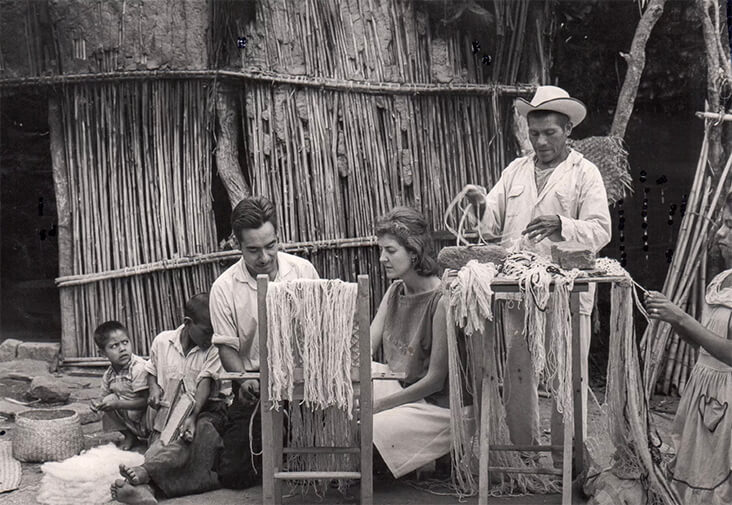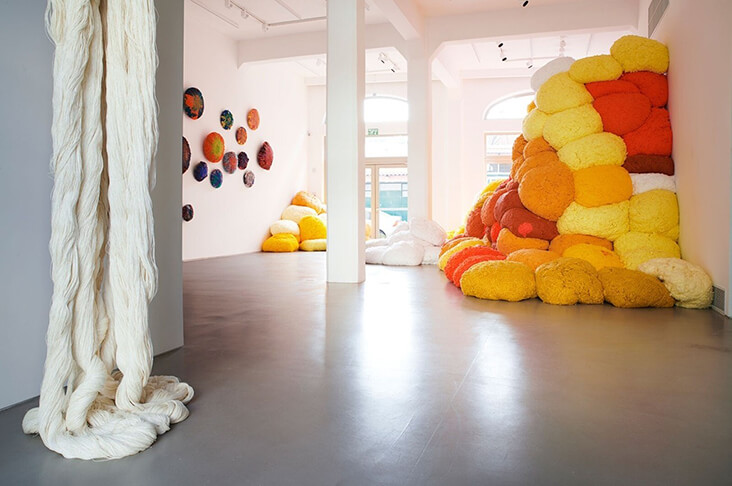The Magic of Yarn: Sheila Hicks’ Technicoloured World

Sheila Hicks weaving at her home in Taxco el Viejo, Mexico, c.1961–2, photographed by Ferdinand Boesch
American artist Sheila Hicks creates whirlwinds of technicoloured thread, knotting, weaving, twisting and spinning dyed, natural yarns such as wool, linen and silk into richly tactile, all-consuming installations. Since the 1950s, Hicks has been producing woven sculptures of all shapes and sizes, pushing and pulling at the boundaries between art and textiles in order to find a language that is all her own. Hicks earned a widespread following as a leading Fibre Artist of the 1960s alongside Lenore Tawney and Magdalena Abakanowicz, and her wild, exuberant and joyful work is now held in museum collections all around the world. Now aged 87, she shows no signs of slowing down. Instead, she says, “I live in an immense labyrinth composed of great webs, masses of threads, uncharted tunnels, and mountains to climb.”
Sheila Hicks was born in Hastings, Nebraska in 1934, during the Great Depression. During her childhood she lived an itinerant life, moving wherever her father could find work. Rather than feeling adrift, she revelled in the adventure, calling her early years a “fantastic… migratory existence.” As a young adult Hicks set off to train as an artist at Yale University, where she was taught by the former Bauhaus tutor and painter Josef Albers, who in stilled in her a disciplined understanding of colour that would stay with her for life. But it was the art historian George Kubler who had the most profound impact on Hicks, introducing her to traditional textiles and weaving, and encouraging her to travel in order to experience them first hand.
Hicks won a Fulbright Scholarship from 1957-58 to study and paint in Chile, and it was while here that she first began to make her own fibre art. She also made extended visits to Chile, South Africa, Morocco and India, where she gained a deeper understanding of textiles from around the world, learning, as she put it: “Textile is a universal language. In all of the cultures of the world, textile is a crucial and essential component.” From 1959 to 1964, Hicks settled in Taxco el Viejo in Mexico, were she lived in amongst traditional craftspeople and learned first hand their ancient weaving traditions.
In 1964, Hicks relocated to Paris, where she continues to live and work today. In Paris Hicks continued to develop her weaving practice. One of her first collaborative ventures came with the furniture company Knoll, for whom she created a nubby fabric called Inca, influenced by Andean patterns and colours. Hicks took on further commercial ventures with the Rochester Institute of Technology, the Ford Foundation, the Eero Saarinen designed CBS Headquarters and Mexico’s Camino Real Hotel, among many other, producing wall-sized woven tapestries featuring abstract, geometric designs, and richly textured surfaces. Over time her tapestries became increasingly three-dimensional, projecting outwards from the wall into the room beyond, or hung suspended from ceiling to floor in twists and plaits like Rapunzel’s hair.
While Hicks continues to work on small scale weavings on a daily basis, her practice is now predominantly centred on the production of huge, all-encompassing environments, many comprised of vast, electro-bright yarn balls heaped into great, mountainous piles, fantastical worlds begging to be jumped into or climbed over. She says working on these massive installations is akin to making a painting: “A little bit more here, a little more here, paint over that, pull that out. It’s not like working on a loom where you set up a programme. It’s intuitive: stroke by stroke. I can change it at any moment.”
While it’s clear that Hicks has had a profound impact on a whole host of cotemporary artists who see in her work the wild and spontaneous potential of thread, that was never Hicks’ intention. She says, “I don’t want a legacy. I just want to have fun while I’m here.” But after a lifetime of making weavings in just about every size, material and variation possible, she still continues to emphasize the importance of challenging herself, and expecting the unexpected. “I don’t want to go do something I know how to do,” she says, “I want to do something I don’t know how to do.”





















































2 Comments
Jay Evert
Wonderful color harmonies.
Vicki Lang
This is a woman after my own heart. I love the bold colors she uses and like her I want to learn something from the projects I make. I don’t like repeats if I can help it. Thank you for an other wonderful article.